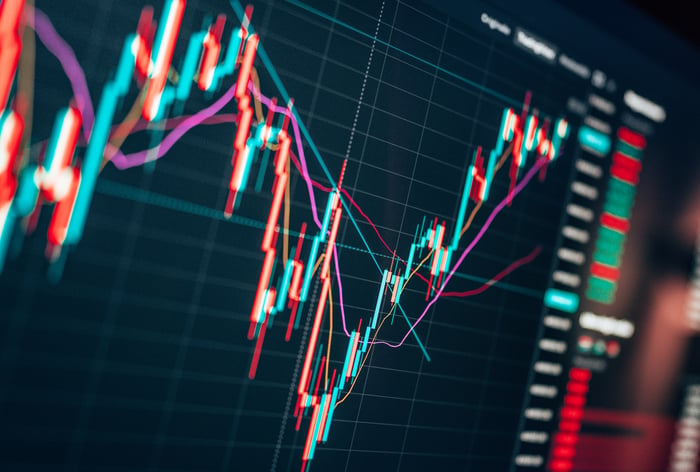Wall Street has been nothing short of a roller-coaster ride since this decade began. Over nearly four years, the major stock indexes have vacillated between bull and bear markets, with the pendulum for the growth-driven Nasdaq-100 swinging the most. The Nasdaq-100 is comprised of the 100 largest nonfinancial companies listed on the Nasdaq stock exchange.
After losing a third of its value during the 2022 bear market, the Nasdaq-100 has catapulted higher by 40% this year, as of the closing bell on Nov. 7. Nevertheless, this highly watched index remains 8% below its record-closing high, which was set almost two years ago.

Image source: Getty Images.
To some investors, this decline represents a lost two years for growth stocks. But for opportunistic investors with a long-term mindset, it's a red-carpet opportunity to snag deals. Just keep in mind that not all 100 companies within the Nasdaq-100 are worth buying.
As we push forward in November, two Nasdaq-100 stocks have risen above the pack as no-brainer buys, while another widely owned growth stock is very clearly worth avoiding.
Nasdaq-100 stock No. 1 that's a no-brainer buy in November: PayPal Holdings
The first Nasdaq-100 stock that's nothing short of a no-brainer buy for long-term-minded investors in November is fintech giant PayPal (PYPL 2.90%).
Shares of PayPal have tumbled more than 80% from their all-time high on fears that the digital payment space is getting crowded. Evidence of increasing competition can be seen with the company's gross margin modestly declining.
The other concern for PayPal has been the health of the U.S. economy. Above-average core inflation and the potential for economic growth to slow threatens to reduce the spending activity of low-earning consumers. Since PayPal is a fee-based business, and its fees are driven by usage, fewer digital payments and/or users on its network would be a recipe for slower sales and profit growth.
While these are, indeed, tangible concerns, neither are game changers for the world's leading digital payments company.
Even with some degree of softening in PayPal's key performance indicators, the one metric that continues to point meaningfully higher is active account engagement. When 2020 came to a close, the average active PayPal account was conducting 40.9 transactions over the trailing-12-month period. As of the close of September 2023, this same active account is completing an average of 56.6 transactions over the trailing 12 months. That's a 38.4% increase in engagement among its active users in less than three years. As a usage-driven business, this signals that PayPal's gross profit is almost certainly headed higher.
PayPal also has a new CEO holding the reins. Alex Chriss took over in late September as the company's new chief, and he brings a belt-tightening culture to the table that PayPal sorely needs. Though Chriss will be looking to grow PayPal into new payment avenues, his first task will be to lower the company's cost structure and halt its gross margin decline.
PayPal's undeniably cheap valuation is also difficult to ignore. Despite a high-single-digit sales growth rate, shares of the company can be purchased for less than 10 times forward-year earnings. That's the cheapest valuation for PayPal since going public.
Nasdaq-100 stock No. 2 that's a no-brainer buy in November: JD.com
A second Nasdaq-100 stock that's begging to be bought in November is China-based e-commerce company JD.com (JD 6.12%).
In addition to concerns about the health of the U.S. and global economy, China stocks have their own unique headwinds. This includes regulatory and governmental oversight that can, at times, be unpredictable, as well as China's approach to the COVID-19 pandemic. For more than three years, China attempted to mitigate the spread of the SARS-CoV-2 virus that causes COVID-19 by locking down cities and provinces. Although China's "zero-COVID" mitigation strategy has ended, the detrimental supply chain effects from these lockdowns are still being felt.
The other side to the above coin is that an open Chinese economy is a pathway to growth. JD.com is the No. 2 e-commerce provider in the world's No. 2 economy by gross domestic product. Moving past the last economic "hiccups" associated with the COVID-19 pandemic should lead to improved consumer purchasing power.
Although JD takes a backseat to Alibaba in terms of e-commerce market share in China, it offers an operating model with a higher ceiling. Whereas Alibaba generates most of its revenue by acting as a third-party marketplace, JD is almost entirely reliant on direct-to-consumer (DTC) sales. This is to say that JD handles the inventory of goods purchased on its platform and the logistics of delivering those items. Controlling the DTC process gives JD more leverage on its margins than rival Alibaba, which, over time, should lead to superior operating margin.
Furthermore, JD.com is making moves designed to bolster its growth and unlock value for its shareholders. In late March, the company announced plans to spin off its property and industrial segments, which should make it easier for investors to break down where JD's core growth is coming from. JD has also been investing in various artificial intelligence initiatives, such as drones and autonomous delivery technology.
Similar to PayPal, JD.com is historically inexpensive. Shares can be purchased right now for roughly 8 times forward-year earnings. To boot, its $42.6 billion market cap is currently less than $13 billion more than its net cash, cash equivalents, and short-term investments, as of June 30, 2023. In short, it's a screaming bargain.

Image source: Getty Images.
The Nasdaq-100 stock to avoid like the plague in November: Costco Wholesale
However, not all Nasdaq-100 stocks are necessarily worth buying. Though it's a highly successful company, leaving warehouse club Costco Wholesale (COST 1.01%) on the shelf in November would be advisable.
To reiterate, Costco isn't a bad business. It's been using its size and deep pockets to win over consumers in major markets for decades. The company's bulk buying results in lower per-unit costs. These cost savings are then passed along to its members, which is what allows it to undercut most grocery chains, along with mom-and-pop shops, on price.
Costco Wholesale's membership model is a big-time moneymaker, too. Subscriptions drive the bulk of Costco's operating margin and serve as a means to keep its customers loyal to its ecosystem of products and services. In short, Costco is very profitable and I'd expect it to stay that way.
But Costco isn't a good value. While an argument can be made that Costco's competitive advantages merit a premium valuation, paying more than 33 times forward-year earnings for a company with mid-single-digit sales growth prospects makes little sense in the current environment. The Federal Reserve has raised interest rates by more than 500 basis points since March 2022, which means consumers are going to be less likely to open their wallets.
To make matters worse, Costco's operating expenses have been matching or outpacing net sales growth. The increase in merchandise costs and net sales were effectively stride for stride in fiscal 2023 (ended Sept. 3, 2023), while the 9.2% uptick in selling, general, and administrative expenses outpaced the 6.8% growth in net sales. This appears to signal that even the mighty Costco is struggling to deal with a higher-cost environment.
Although Costco has the advantage of selling nondiscretionary goods (e.g., food, beverages, household cleaning products, and so on), which'll draw members into its stores in any economic climate, it's going to have a near-impossible task of making good on a forward price-to-earnings ratio of 33.4 with a very modest growth rate.
With Costco seemingly priced for perfection, it makes for an easy avoid in November.





